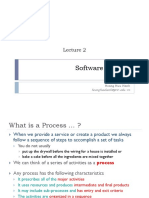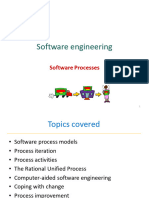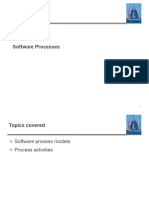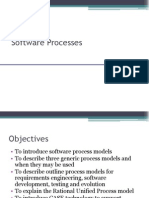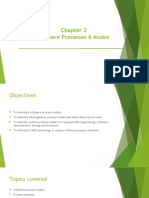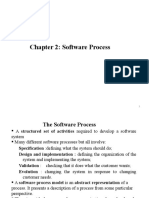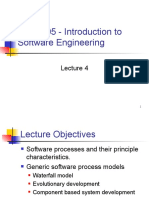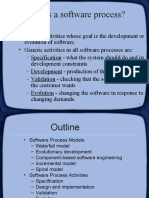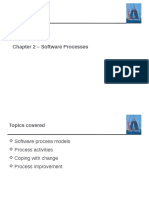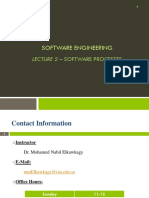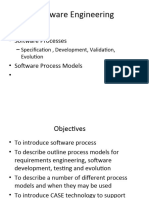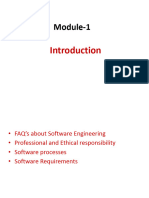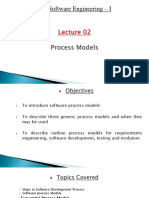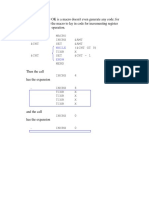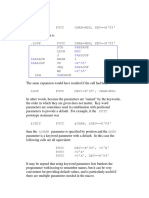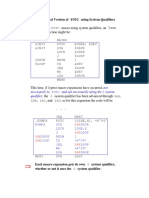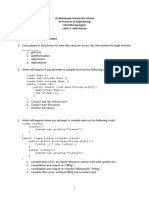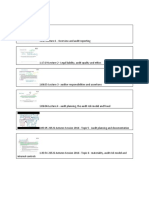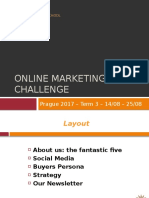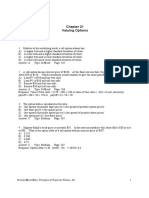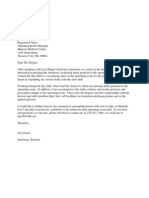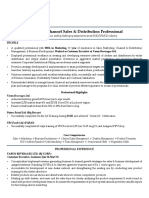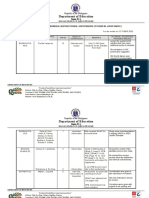Software Processes
Overview
Don Evans CSE
http://lyle.smu.edu/~devans/4345/SW%20Process%20Overview.ppt
�The Software Development
Process
A structured set of activities required to develop a
software system
Specification;
Design;
Implementation;
Validation;
Evolution.
A software process model is an abstract
representation of a process. It presents a
description of a process from some particular
perspective.
2
�Generic Software Process
Models
The waterfall model
Separate and distinct phases of specification and
development.
Evolutionary development
Specification, development and validation are
interleaved.
Component-based software engineering
The system is assembled from existing components.
There are many variants of these models e.g.
formal development where a waterfall-like process
is used but the specification is a formal
specification that is refined through several stages
to an implementable design.
3
�Waterfall Model
Requirements
defi nition
System and
software design
Implementa
tion
and unit testing
Integration and
system testing
Operation and
maintenance
�Waterfall Model Problems
Inflexible partitioning of the project into
distinct stages makes it difficult to respond
to changing customer requirements.
Therefore, this model is only appropriate
when the requirements are wellunderstood and changes will be fairly
limited during the design process.
Few business systems have stable
requirements.
5
�Evolutionary development
Exploratory development
Objective is to work with customers and to
evolve a final system from an initial outline
specification. Should start with well-understood
requirements and add new features as
proposed by the customer.
Throw-away prototyping
Objective is to understand the system
requirements. Should start with poorly
understood requirements to clarify what is
really needed.
6
�Evolutionary development
Concurrent
activities
Specifi ca
tion
Outline
description
Development
Validation
Initial
version
Intermediate
versions
Final
version
�Evolutionary development
Problems
Lack of process visibility;
Systems are often poorly structured;
Special skills (e.g. in languages for rapid
prototyping) may be required.
Applicability
For small or medium-size interactive systems;
For parts of large systems (e.g. the user
interface);
For short-lifetime systems.
8
�Component-Based Software
Engineering
Based on systematic reuse where systems
are integrated from existing components or
COTS (Commercial-off-the-shelf) systems.
Process stages
Component analysis;
Requirements modification;
System design with reuse;
Development and integration.
This approach is becoming increasingly used
as component standards have emerged.
�A Reuse-Oriented
Development Process
Requirements
specifi cation
Component
analysis
Requirements
modifi cation
System design
with reuse
Development
and integ
ration
System
validation
10
�Process Iteration
System requirements ALWAYS evolve in the
course of a project so process iteration
where earlier stages are reworked is always
part of the process for large systems.
Iteration can be applied to any of the
generic process models.
Two (related) approaches
Incremental delivery;
Spiral development.
11
�Incremental delivery
Rather than deliver the system as a single
delivery, the development and delivery is broken
down into increments with each increment
delivering part of the required functionality.
User requirements are prioritised and the highest
priority requirements are included in early
increments.
Once the development of an increment is started,
the requirements are frozen though requirements
for later increments can continue to evolve.
12
�Incremental development
Defi ne outline
requirements
Develop system
increment
Assign requirements
to increments
Validate
increment
Design system
architectur
e
Integrate
increment
Validate
system
Final
system
System incomplete
13
�Incremental Development
Advantages
Customer value can be delivered with
each increment so system functionality
is available earlier.
Early increments act as a prototype to
help elicit requirements for later
increments.
Lower risk of overall project failure.
The highest priority system services
tend to receive the most testing.
14
�Spiral Development
Process is represented as a spiral rather
than as a sequence of activities with
backtracking.
Each loop in the spiral represents a phase
in the process.
No fixed phases such as specification or
design - loops in the spiral are chosen
depending on what is required.
Risks are explicitly assessed and resolved
throughout the process.
15
�Spiral model of the software
process
Determine objectives,
alternatives and
constraints
Evaluate alternatives,
identify, resolve risks
Risk
analysis
Risk
analysis
Risk
analysis
REVIEW
Requirements plan
Life-cycle plan
Plan ne xt phase
Operational
protoype
Pr ototype 3
Pr ototype 2
Risk
analysis Pr ototype 1
Simulations, models, benchmarks
Concept of
Operation
S/W
requirements
Development
plan
Requirement
validation
Integration
and test plan
Design
V&V
Acceptance
test
Service
Product
design
Detailed
design
Code
Unit test
Integration
test
Develop, verify
next-level product
16
�Spiral Model Sectors
Objective setting
Specific objectives for the phase are identified.
Risk assessment and reduction
Risks are assessed and activities put in place to
reduce the key risks.
Development and validation
A development model for the system is chosen
which can be any of the generic models.
Planning
The project is reviewed and the next phase of
the spiral is planned.
17
�Process activities
Software
Software
Software
Software
specification
design and implementation
validation
evolution
18
�Software Specification
The process of establishing what
services are required and the
constraints on the systems operation
and development.
Requirements engineering process
Feasibility study;
Requirements elicitation and analysis;
Requirements specification;
Requirements validation.
19
�The Requirements Engineering
Process
Feasibility
study
Requirements
elicitation and
analy sis
Requirements
specifi cation
Requirements
validation
Feasibility
report
System
models
User and system
requirements
Requirements
document
20
�Software Design and
Implementation
The process of converting the system
specification into an executable system.
Software design
Design a software structure that realises the
specification;
Implementation
Translate this structure into an executable
program;
The activities of design and implementation
are closely related and may be inter-leaved.
21
�Design Process Activities
Architectural design
Abstract specification
Interface design
Component design
Data structure design
Algorithm design
22
�The Software Design
Process
Requir
ements
specifi ca
tion
Design acti
vities
Architectur
al
design
Abstract
specifi ca
tion
Interface
design
Component
design
Data
structur
e
design
Algorithm
design
System
architectur
e
Software
specifi ca
tion
Interface
specifi ca
tion
Component
specifi ca
tion
Data
structur
e
specifi ca
tion
Algorithm
specifi ca
tion
Design pr
oducts
23
�Structured Methods
Systematic approaches to developing a
software design.
The design is usually documented as a
set of graphical models.
Possible models
Object model;
Sequence model;
State transition model;
Structural model;
Data-flow model.
24
�Programming and
Debugging
Translating a design into a program and
removing errors from that program.
Programming is a personal activity there is no generic programming
process.
Programmers carry out some program
testing to discover faults in the
program and remove these faults in the
debugging process.
25
�Software Validation
Verification and validation (V & V) is
intended to show that a system conforms
to its specification and meets the
requirements of the system customer.
Involves checking and review processes
and system testing.
System testing involves executing the
system with test cases that are derived
from the specification of the real data to
be processed by the system.
26
�The testing process
Component
testing
System
testing
Ac c eptanc e
testing
27
�Testing stages
Component or unit testing
Individual components are tested
independently;
Components may be functions or objects or
coherent groupings of these entities.
System testing
Testing of the system as a whole. Testing of
emergent properties is particularly important.
Acceptance testing
Testing with customer data to check that the
system meets the customers needs.
28
�Testing Phases
Requirements
specifi ca
tion
System
specifi ca
tion
System
integration
test plan
Acceptance
test plan
Service
System
design
Acceptance
test
Detailed
design
Sub-system
integration
test plan
System
integration test
Module and
unit code
and test
Sub-system
integration test
29
�Software evolution
Software is inherently flexible and can change.
As requirements change through changing
business circumstances, the software that
supports the business must also evolve and
change.
Although there has been a demarcation
between development and evolution
(maintenance) this is increasingly irrelevant as
fewer and fewer systems are completely new.
30
�System evolution
Defi ne system
requirements
Assess existing
systems
Existing
systems
Propose system
changes
Modify
systems
New
system
31
�The Rational Unified Process
A modern process model derived from
the work on the UML and associated
process.
Normally described from 3 perspectives
A dynamic perspective that shows phases
over time;
A static perspective that shows process
activities;
A practive perspective that suggests good
practice.
32
�RUP Phases
Inception
Establish the business case for the system.
Elaboration
Develop an understanding of the problem
domain and the system architecture.
Construction
System design, programming and testing.
Transition
Deploy the system in its operating environment.
33
�RUP Best Practice
Develop software iteratively
Manage requirements
Use component-based architectures
Visually model software
Verify software quality
Control changes to software
34
�Best Practice 1: Develop
Iteratively
35
�Waterfall Development
Characteristics
WaterfallProcess
Requirements
analysis
Design
Codeandunittest
Subsystemintegration
Systemtest
Delays confirmation of
critical risk resolution
Measures progress by
assessing work-products
that are poor predictors of
time-to-completion
Delays and aggregates
integration and testing
Precludes early deployment
Frequently results in major
unplanned iterations
36
�Iterative Development
Produces an Executable
Requirements
Analysis & Design
Planning
Implementation
Initial
Planning
Management
Environment
Test
Evaluation
Each iteration
results in an
executable release
Deployment
37
�Risk Profiles
Risk
WaterfallRisk
RiskReduction
RiskReduction
IterativeRisk
Time
38
�Best Practice 2: Manage
Requirements
39
�Aspects of Requirements
Management
Analyze the Problem
Understand User Needs
Define the System
Manage Scope
Refine the System Definition
Manage Changing Requirements
40
�Best Practice 3: Use
Component-Based
Architectures
41
�Purpose of a Component-Based
Architecture
Basis for reuse
Component reuse
Architecture reuse
Component-based
architecture with
layers
Basis for project management
Planning
Staffing
Delivery
Intellectual control
Manage complexity
Maintain integrity
Applicationspecific
Businessspecific
Middleware
Systemsoftware
42
�Best Practice 4: Model
Visually
43
�Visual Modeling with Unified Modeling Language
Multiple views
Precise syntax and semantics
Sequence
Diagrams
Collaboration
Diagrams
Dynamic
Diagrams
Statechart
Diagrams
Class
Diagrams
Use-Case
Diagrams
Object
Diagrams
Component
Diagrams
Models
Activity
Diagrams
Deployment
Diagrams
Static
Diagrams
44
�Best Practice 5:
Continuously Verify Quality
45
�Continuously Verify Your
Softwares Quality
Software problems are
100 to 1000 times more costly
to find and repair after deployment
CosttoRepairSoftware
CostofLostOpportunities
Cost
CostofLostCustomers
Inception
Elaboration
Construction
Transition
46
�Test Each Iteration
Iteration1
Iteration2
Iteration3
Iteration4
TestSuite1
TestSuite2
TestSuite3
TestSuite4
UMLModel
and
Implementation
Tests
47
�Best Practice 6: Manage
Change
48
�Aspects of a CM System
Change Request Management (CRM)
Configuration Status Reporting
Configuration Management (CM)
Change Tracking
Version Selection
Software Manufacture
49
�RUP is Organization Along Time
Time
Organizationbyphaseshelpsminimizetherisksofresourceallocation.
50
�Major Milestones: Business Decision Points
Productsufficiently
matureforcustomers
Commitresources
forconstruction
Customer
acceptance
orendoflife
Commitresourcesfor
theelaborationphase
Inception
Elaboration
Construction
Transition
time
Lifecycle
Objective
Milestone
Lifecycle
Architecture
Milestone
InitialOperational
Capability
Milestone
Product
Release
51
�What Is an Iteration?
52
�Iteration: Number and
Duration
Duration driven by
+ size of organization
+ size of project
- familiarity with the process, maturity
- technical simplicity
6, plus or minus 3
Inception:
Elaboration:
Construction:
Transition:
0 .. 1
1 .. 3
1 .. 3
1 .. 2
53
�One Iteration
Inan
iteration,you
walkthrough
alldisciplines.
54
�Content
Organization Based on
Content
55
�Nine Disciplines
56
�Artifact Set Evolution Over the Development
Phases
With the
iterative
approach,
artifact sets
mature over
time.
57

